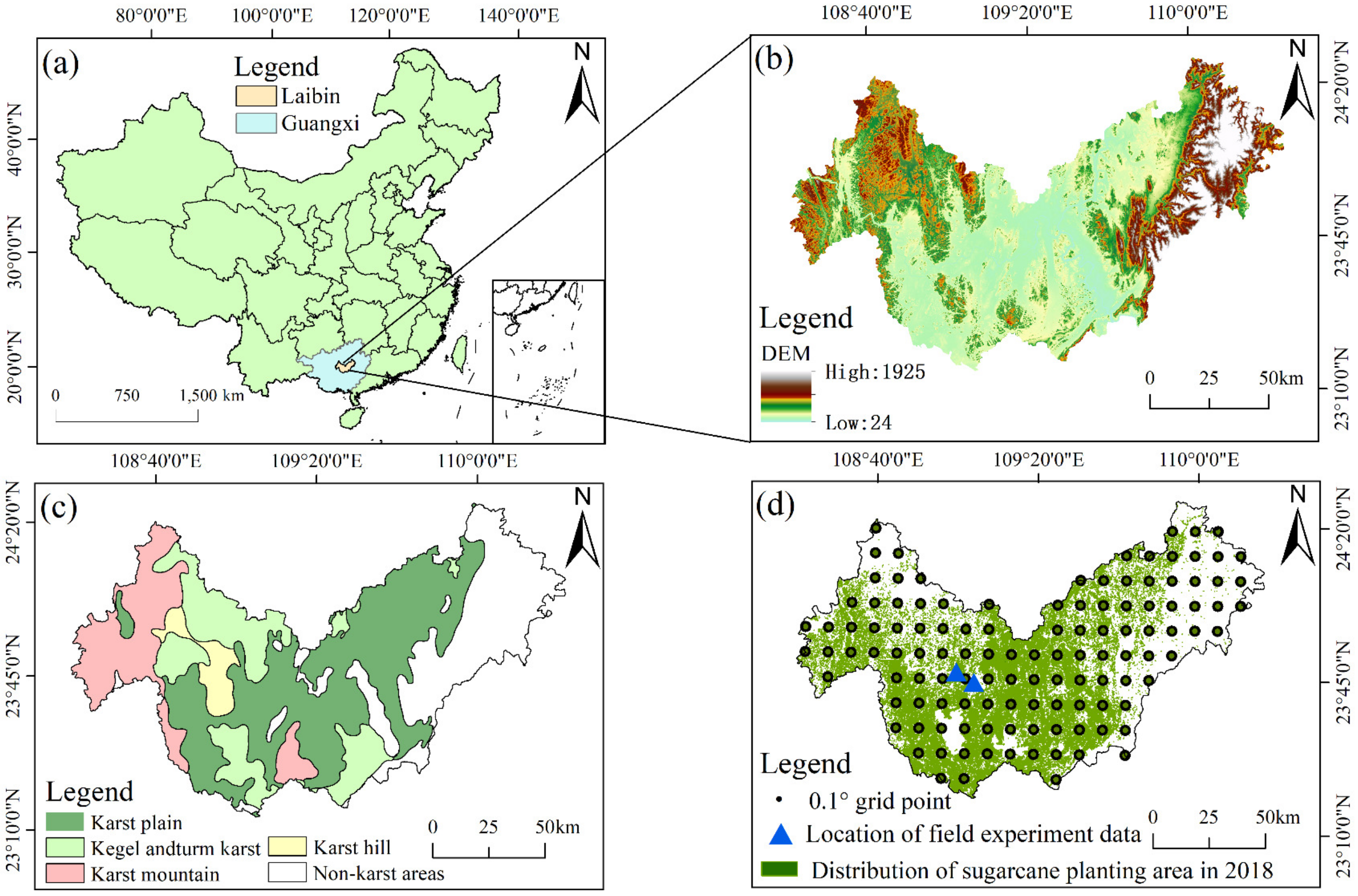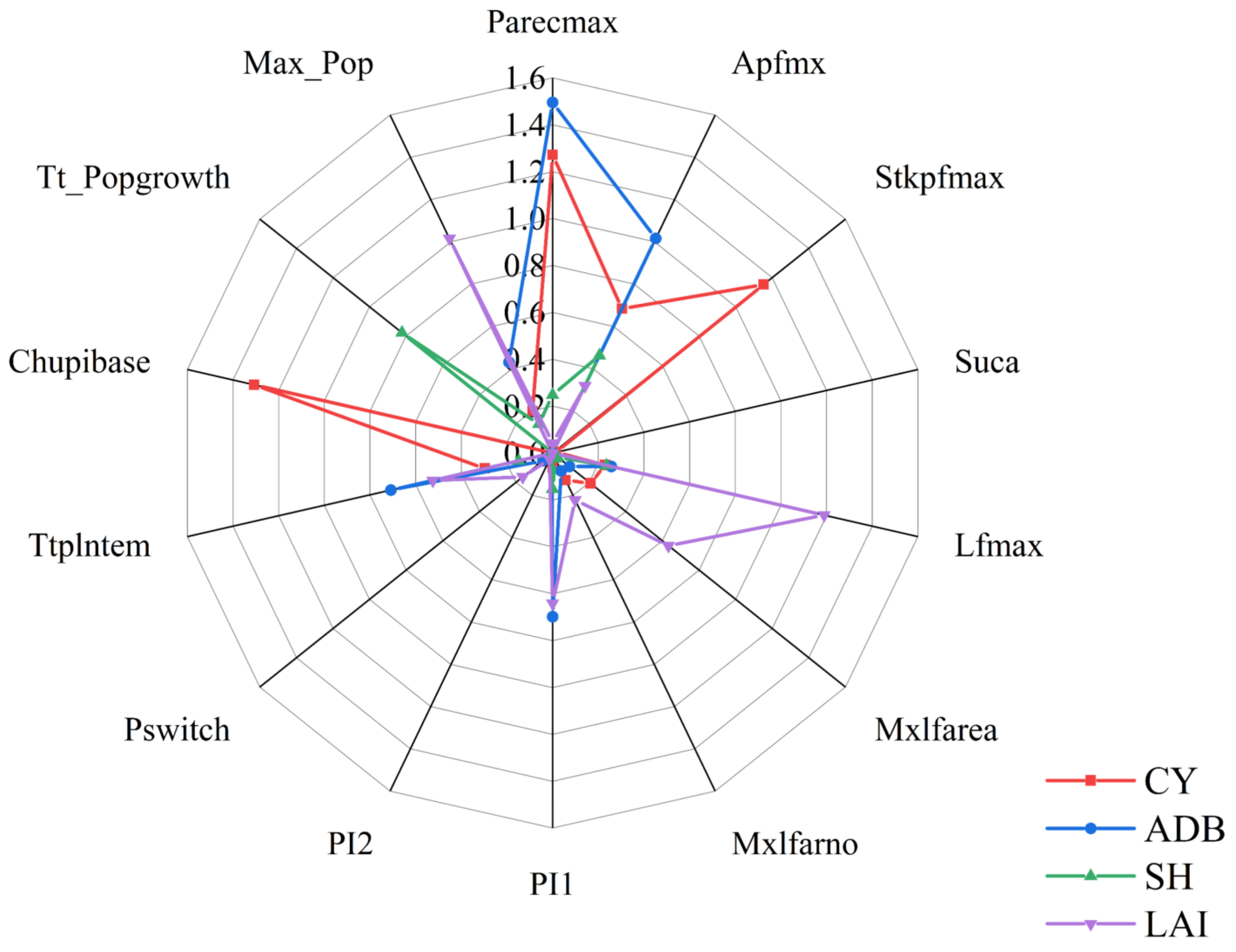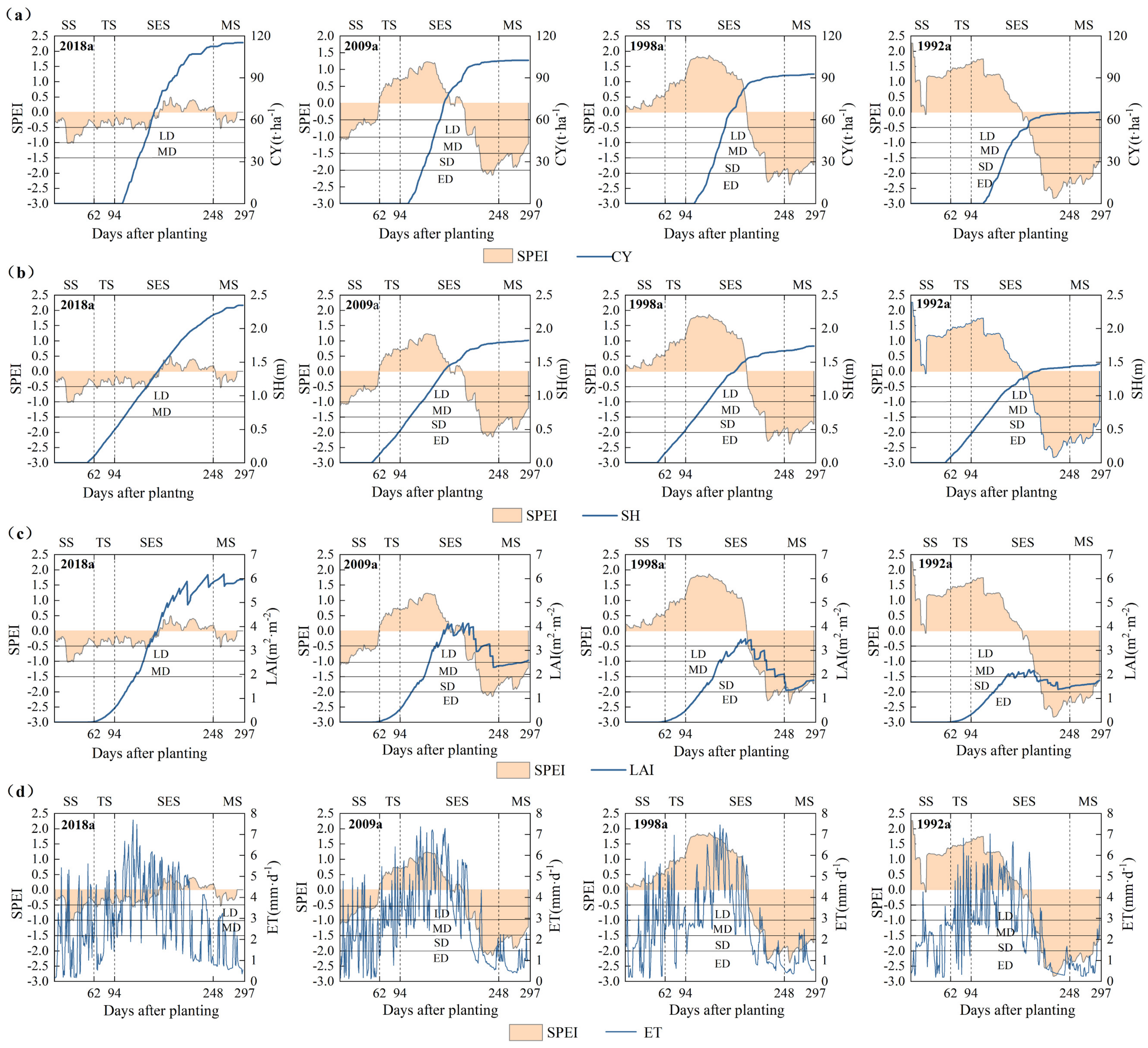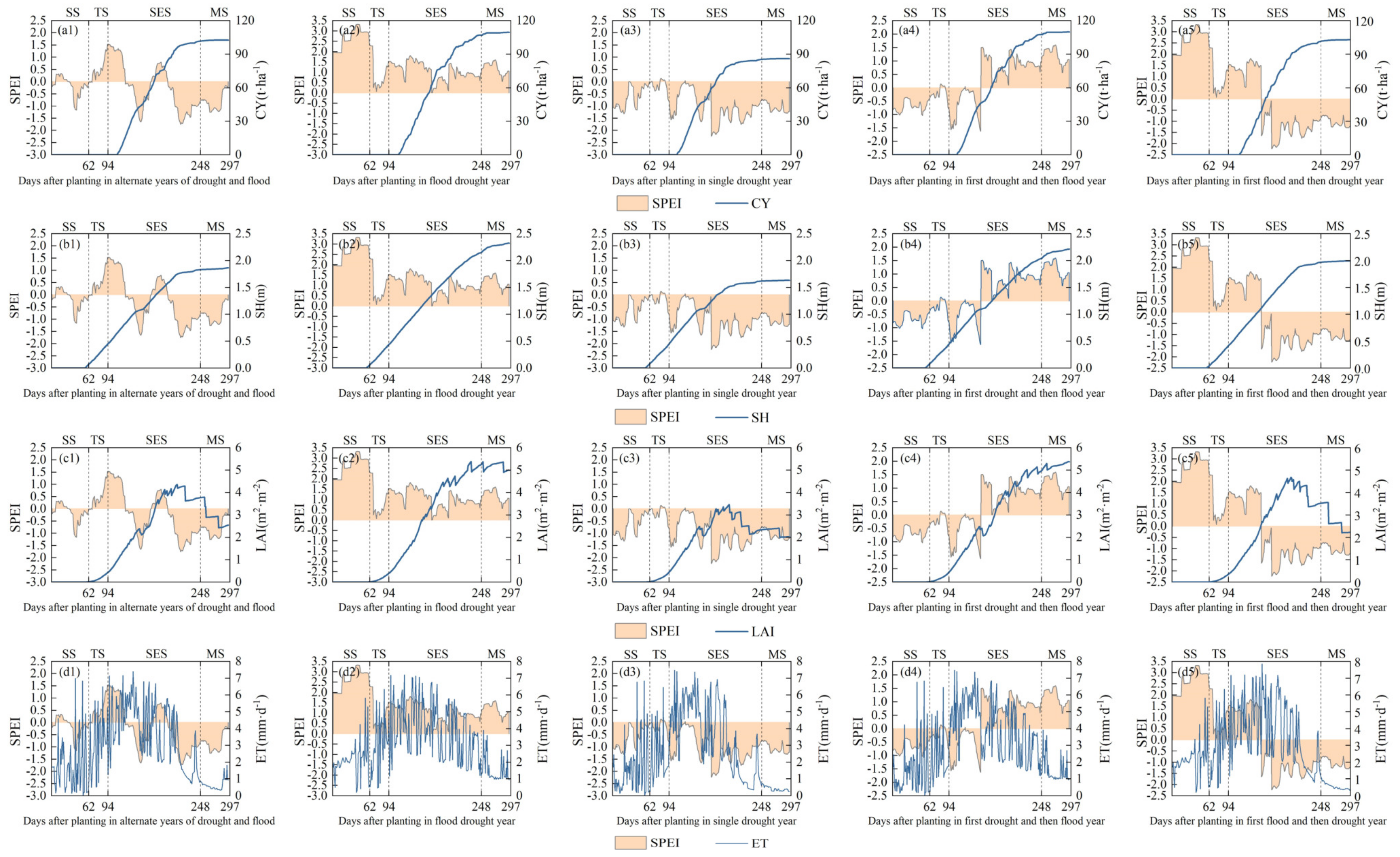The Quantitative Inhibition Effects of Meteorological Drought on Sugarcane Growth Using the Decision Support System for Agrotechnology Transfer-CANEGRO Model in Lai-bin, China
Abstract
:1. Introduction
2. Materials and Methods
2.1. Study Area
2.2. Datasets
2.3. Methodology
- (1)
- Daily SPEI
| Grade | 1 | 2 | 3 | 4 | 5 |
|---|---|---|---|---|---|
| SPEI | SPEI ≥ −0.5 | −1 < SPEI < −0.5 | −1.5 < SPEI ≤ −1 | −2 < SPEI ≤ −1.5 | SPEI ≤ −2 |
| Type | No drought | Light drought | Moderate drought | Severe drought | Extreme drought |
- (2)
- Parameterization method of the DSSAT−CANEGRO Model
3. Results of Meteorological Drought Characteristics in Lai-bin
3.1. Statistical Characteristics of Meteorological Drought
3.2. Drought Simulation Scenario Setting in the Sugarcane Growth Period
4. Results of Model Parameterization and Sugarcane Response Simulation to Historical Meteorological Drought
4.1. Parameter Sensitivity Analysis and Calibration of the DSSAT−CANEGRO Model
4.2. Simulation of Sugarcane Response to Historical Meteorological Drought in Typical Years
5. Results of Sugarcane Growth Response to Meteorological Drought Scenarios
5.1. Scenario Simulation of Meteorological Drought in Different Sugarcane Growth Periods
5.2. Scenario Simulation of Meteorological Drought in a Certain Sugarcane Growth Period
6. Discussion of Drought and Flood Alternation Effects on Cane Growth
7. Conclusions
- (1)
- There are significant differences in the spatial distribution of duration, intensity, and frequency of meteorological drought in Lai-bin, with a duration of more than 100 days/year, with an accumulative intensity of −100~−150 a year, and with a frequency of 1.53 times/year. Droughts occurred mostly at the seedling, stem elongation, and maturity stages of sugarcane, but rarely at the tiller stage. Flash droughts within a month and seasonal droughts longer than a month coexisted in the study area.
- (2)
- The DSSAT−CANEGRO model has a good simulation accuracy concerning the response of sugarcane growth to multiple meteorological drought scenarios in Lai-bin. The greater the intensity and the longer the duration of historical meteorological drought, the stronger the inhibition on the CY, SH, LAI, and ET of sugarcane. The greatest limitation on sugarcane growth occurred during the period of stem elongation, and the LAI responded most sensitively to each level of meteorological dryness.
- (3)
- The occurrence of light drought at the seedling stage and light, moderate, and severe drought at the maturity stage in Lai-bin had a promotion effect on sugarcane growth, but the overall increase rate of CY was less than 5%. Droughts of all intensities which occurred during the stem elongation stage represented a significant inhibitory effect on CY accumulation, which could lead to final yield reductions of 7.12% (light drought), 16.48% (moderate drought), 18.80% (severe drought), and 29.05% (extreme drought).
- (4)
- Alternate drought–flood scenarios had a remarkable effect on different periods of sugarcane growth in Lai-bin. The full drought scenario produced the strongest inhibitory effect on sugarcane growth, and the one-drought-to-flood scenario emerged as a facilitation effect on CY and SH more than the full-flood scenario did. The scenario of multiple alternations of droughts and floods led to a superimposed yield reduction on sugarcane, which was a slightly stronger inhibitory effect on sugarcane growth than that of the one-flood-to-drought scenario.
Author Contributions
Funding
Institutional Review Board Statement
Data Availability Statement
Conflicts of Interest
References
- Gupta, A.; Rico-Medina, A.; Caño-Delgado, A.I. The physiology of plant responses to drought. Science 2020, 368, 266–269. [Google Scholar] [CrossRef] [PubMed]
- Li, W.; Pacheco-Labrador, J.; Migliavacca, M.; Miralles, D.; Hoek van Dijke, A.; Reichstein, M.; Forkel, M.; Zhang, W.; Frankenberg, C.; Panwar, A. Widespread and complex drought effects on vegetation physiology inferred from space. Nat. Commun. 2023, 14, 4640. [Google Scholar] [CrossRef] [PubMed]
- Veresoglou, S.D.; Li, G.C.; Chen, J.; Johnson, D. Direction of plant–soil feedback determines plant responses to drought. Glob. Chang. Biol. 2022, 28, 3995–3997. [Google Scholar] [CrossRef] [PubMed]
- Zhang, X.; Hao, Z.; Singh, V.P.; Zhang, Y.; Feng, S.; Xu, Y.; Hao, F. Drought propagation under global warming: Characteristics, approaches, processes, and controlling factors. Sci. Total Environ. 2022, 838, 156021. [Google Scholar] [CrossRef] [PubMed]
- Zhao, R.; Sun, H.; Xing, L.; Li, R.; Li, M. Effects of anthropogenic climate change on the drought characteristics in China: From frequency, duration, intensity, and affected area. J. Hydrol. 2023, 617, 129008. [Google Scholar] [CrossRef]
- Zhang, Q.; Miao, C.; Gou, J.; Zheng, H. Spatiotemporal characteristics and forecasting of short-term meteorological drought in China. J. Hydrol. 2023, 624, 129924. [Google Scholar] [CrossRef]
- Chen, L.; He, Z.; Pan, S.; Gu, X.; Xu, M.; You, M.; Pi, G. Spatial and Temporal Evolution Characteristics of Karst Agricultural Drought Based on Different Time Scales and Driving Detection-A Case Study of Guizhou Province. J. Soil Water Conserv. 2023, 37, 136–148. [Google Scholar]
- Mokhtar, A.; He, H.; Alsafadi, K.; Mohammed, S.; Ayantobo, O.O.; Elbeltagi, A.; Abdelwahab, O.M.; Zhao, H.; Quan, Y.; Abdo, H.G. Assessment of the effects of spatiotemporal characteristics of drought on crop yields in southwest China. Int. J. Climatol. 2022, 42, 3056–3075. [Google Scholar] [CrossRef]
- Li, Y.; Yang, L. Sugarcane Agriculture and Sugar Industry in China. Sugar Tech. 2015, 17, 1–8. [Google Scholar] [CrossRef]
- Tan, J.; Guo, J.; Wu, J.; Pan, W.; Bai, Y.; Huang, K.; He, L.; Wu, W.; Shao, J. Photosynthetic characteristics of sugarcane under different irrigation modes. Trans. Chin. Soc. Agric. Eng. 2016, 32, 150–158. [Google Scholar]
- Guo, C.; Cui, Y.; Li, X.; Su, S. Spatial variation of sugarcane water requirement and irrigation quota in Guangxi. Trans. Chin. Soc. Agric. Eng. 2016, 32, 89–97. [Google Scholar]
- Chen, Y.; Meng, L.; Huang, X.; Mo, J.; Feng, L. Spatial and temporal evolution characteristics of drought in Guangxi during sugarcane growth period based on SPEI. Trans. Chin. Soc. Agric. Eng. 2019, 35, 149–158. [Google Scholar]
- Gao, S.; Luo, J.; Zhang, H.; Xu, R. Physiological and biochemical indexes of drought resistance of sugarcane (Saccharum spp.). J. Appl. Ecol. 2006, 17, 1051–1054. [Google Scholar] [CrossRef]
- Zhao, P.; Zhao, J.; Liu, J.; Zan, F.; Xia, H.; Jackson, P.; Basnayake, J.; Inman-Bamber, N.; Yang, K.; Zhao, L. Genetic variation of four physiological indexes as impacted by water stress in sugarcane. Sci. Agric. Sin. 2017, 50, 28–37. [Google Scholar]
- Lu, Z.; Yang, L.; Xing, Y.; Li, Y. Research advances on sugarcane response to Drought stress. Mol. Plant Breed. 2021, 21, 2051–2060. [Google Scholar]
- Teng, Z. The Effect of MCP on Improving Drought Resistance in Sugarcane Seedling Stage; Guangxi University: Nanning, China, 2013. [Google Scholar]
- Sun, Y.; Shen, S. Research progress in application of crop growth models. Chin. J. Agrometeorol. 2019, 40, 444. [Google Scholar]
- Jones, M.R.; Singels, A. Refining the Canegro model for improved simulation of climate change impacts on sugarcane. Eur. J. Agron. 2018, 100, 76–86. [Google Scholar] [CrossRef]
- Marin, F.R.; Jones, J.W.; Royce, F.; Suguitani, C.; Donzeli, J.L.; Filho, W.J.P.; Daniel, S.P.N. Parameterization and evaluation of predictions of DSSAT/CANEGRO for Brazilian sugarcane. Agron. J. 2011, 103, 303–315. [Google Scholar] [CrossRef]
- Singels, A.; Jones, M.; Marin, F.; Ruane, A.; Thorburn, P. Predicting climate change impacts on sugarcane production at sites in Australia, Brazil and South Africa using the Canegro model. Sugar Tech. 2014, 16, 347–355. [Google Scholar] [CrossRef]
- Murilo, D.S.V.; Sentelhas, P.C. Performance of DSSAT CSM-CANEGRO under operational conditions and its use in determining the ‘saving irrigation’ impact on sugarcane crop. Sugar Tech. 2016, 18, 1–12. [Google Scholar] [CrossRef]
- Zha, Y.; Wu, X.; He, X.; Zhang, H.; Gong, F.; Cai, D.; Zhu, P.; Gao, H. Basic soil productivity of spring maize in black soil under long-term fertilization based on DSSAT model. J. Integr. Agric. 2014, 13, 577–587. [Google Scholar] [CrossRef]
- Fang, G.; Tu, Y.; Wen, X.; Yan, M.; Tan, Q. Study on the development process and evolution characteristics of meteorological drought in the Huaihe River Basin from 1961 to 2015. J. Hydraul. Eng. 2019, 50, 598–611. [Google Scholar] [CrossRef]
- Lang, J.; Zhang, B.; Ma, B.; Wei, J.; Zhang, J.; Ma, S. Drought evolution characteristics on the Tibetan Plateau based on daily standardized precipitation evapotranspiration index. J. Glaciol. Geocryol. 2018, 40, 1100–1109. [Google Scholar]
- Liu, X.; Leng, X.; Sun, G.; Peng, Y.; Huang, Y.; Yang, Q. Assessment of drought characteristics in Yunnan Province based on SPI and SPEI from 1961 to 2100. Trans. Chin. Soc. Agric. Mach. 2018, 49, 299. [Google Scholar]
- He, J.; Yang, K.; Tang, W.; Lu, H.; Qin, J.; Chen, Y.; Li, X. The first high-resolution meteorological forcing dataset for land process studies over China. Sci. Data 2020, 7, 1–12. [Google Scholar] [CrossRef] [PubMed]
- Liu, X.; Zhu, X.; Pan, Y.; Li, S.; Liu, Y. Agricultural drought monitor: Progress, challenges and prospect. Acta Geogr. Sin. 2015, 70, 1835–1848. [Google Scholar]
- Wang, Q.; Shi, P.; Lei, T.; Geng, G.; Liu, J.; Mo, X.; Li, X.; Zhou, H.; Wu, J. The alleviating trend of drought in the Huang-Huai-Hai Plain of China based on the daily SPEI. Int. J. Climatol. 2015, 35, 3760–3769. [Google Scholar] [CrossRef]
- Li, T. High-yielding and stable high-sugar cultivation technology of sugarcane in Laibin. Xiangcun Keiji 2017, 15, 63–64. [Google Scholar] [CrossRef]
- Qin, S. Sugarcane pest and disease prevention and control measures for “double-high” sugarcane base in Laibin City. Jiangxi Agric. 2020, 08, 24. [Google Scholar] [CrossRef]
- Xie, X.; Yang, Y.; Tian, Y.; Liao, L.; Mo, C.X.W.; Zhou, J. Sugarcane planting area and growth monitoring based on remote sensing in Guangxi. Chin. J. Eco-Agric. 2021, 29, 410. [Google Scholar] [CrossRef]
- Deng, Y.H.; Wang, S.J.; Bai, X.Y.; Luo, G.J.; Wu, L.H.; Chen, F.; Wang, J.F.; Li, Q.; Li, C.J.; Yang, Y.J.; et al. Spatiotemporal dynamics of soil moisture in the karst areas of China based on reanalysis and observations data. J. Hydrol. 2020, 585, 124744. [Google Scholar] [CrossRef]
- Wang, L.; Zhang, X.; Fang, Y.; Xia, D. Applicability assessment of China meteorological forcing dataset in upper Yangtze River Basin. Water Power 2017, 43, 18–22. [Google Scholar]
- Fischer, G.; Nachtergaele, F.; Prieler, S.; Van Velthuizen, H.; Verelst, L.; Wiberg, D. Global Agro-Ecological Zones Assessment for Agriculture (GAEZ 2008); IIASA Laxenburg Austria FAO: Rome, Italy, 2008; Volume 10. [Google Scholar]
- Li, Q.; Lan, J.; Qin, Y.; Lian, W. Eighth round of national new sugarcane variety tests. Sugarcane Canesugar 2013, 5, 1–6. [Google Scholar]
- OuYang, J.; Quan, M.; Huang, H.; Pan, Z.; Wei, X. Preliminary report on the results of sugarcane variety trials in the Qiangjiang cane area. Guangxi Sugar Ind. 2017, 01, 15–19. [Google Scholar]
- Jia, Y.; Zhang, B. Spatial-temporal variability characteristics of extreme drought events based on daily SPEI in the southwest China in recent 55 years. Sci Geogr Sin 2018, 38, 474–483. [Google Scholar] [CrossRef]
- Yevjevich, V. Mean Range of Linearly Dependent Normal Variables with Application to Storage Problems; John Wiley Sons Ltd.: Hoboken, NJ, USA, 1967; Volume 3, pp. 663–671. [Google Scholar] [CrossRef]
- Yang, X.; Yang, Y.; Tian, Y.; Liao, L.; Xie, X.; Mo, C.; Xiao, L. Characteristics of spatiotemporal distribution of rainfall-deficient flash drought in Guangxi. Res. Soil Water Conserv. 2020, 27, 149–157. [Google Scholar] [CrossRef]
- An, Q.; He, H.X.; Gao, J.J.; Nie, Q.W.; Cui, Y.J.; Wei, C.J.; Xie, X.M. Analysis of Temporal-Spatial Variation Characteristics of Drought: A Case Study from Xinjiang, China. Water 2020, 12, 741. [Google Scholar] [CrossRef]
- Verma, A.K.; Garg, P.K.; Prasad, K.S.H.; Dadhwal, V.K. Variety-specific sugarcane yield simulations and climate change impacts on sugarcane yield using DSSAT-CSM-CANEGRO model. Agric. Water Manag. 2023, 275, 108034. [Google Scholar] [CrossRef]
- Saltelli, A.; Ratto, M.; Andres, T.; Campolongo, F.; Cariboni, J.; Gatelli, D.; Saisana, M.; Tarantola, S. Global Sensitivity Analysis. The Primer; John Wiley & Sons, Ltd.: Hoboken, NJ, USA, 2007. [Google Scholar]
- Song, M.; Feng, H.; Li, Z.; Gao, J. Sensitivity analysis of the CERES-Wheat model based on Morris and EFAST. Trans. Chin. Soc. Agric. Mach. 2014, 45, 124–131. [Google Scholar]
- Francesca, C.; Jessica, C.; Andrea, S. An effective screening design for sensitivity analysis of large models—ScienceDirect. Environ. Model. Softw. 2007, 22, 1509–1518. [Google Scholar] [CrossRef]
- Morris, M.D. Factorial Sampling Plans for Preliminary Computational Experiments. Technometrics 2012, 33, 161–174. [Google Scholar] [CrossRef]
- Liu, J.; Chu, Q.; Wang, G.; Chen, B.; Zhang, Y. Simulating yield gap of winter wheat in response to nitrogen management in North China Plain based on DSSAT model. Trans. Chin. Soc. Agric. Eng. 2013, 29, 124–129. [Google Scholar]
- Chen, Y.; Meng, L.; Huang, X.; Jian, F.; Wang, Y.; Mo, W. Spatial and temporal evolution of drought in the karst region of Guangxi from 1971–2017 based on SPEI. J. Arid Meteorol. 2019, 37, 353–362. [Google Scholar]
- Liu, S.; Yang, Q.; Li, X.; Huang, G.; Xiao, G. Effects of drought stress on morphological index and physiological characteristics of sugarcane at different growth stages. J. South. Agric. 2016, 47, 1273–1278. [Google Scholar]
- Luo, S.; Liao, W.; Wei, H.; He, H.; Jiang, Y.; Tang, L. Research progress of drought stress on sugarcane growth. Trop. Agric. 2020, 5, 70–73. [Google Scholar]
- Zu, Q.; Mi, C.; Liu, D.L.; He, L.; Kuang, Z.; Fang, Q.; Ramp, D.; Li, L.; Wang, B.; Chen, Y.; et al. Spatio-temporal distribution of sugarcane potential yields and yield gaps in Southern China. Eur. J. Agron. 2018, 92, 72–83. [Google Scholar] [CrossRef]
- Wang, M.; Bi, W.; Weng, B.; Yu, Z.; Xu, T. Review on impact from drought-flood abrupt alternation on crop growth and yield. Water Resour. Hydropower Eng. 2019, 50, 189–196. [Google Scholar] [CrossRef]








| Growth Period | Dates (Days) | Light Drought (Days) | Moderate Drought (Days) | Severe Drought (Days) | Extreme Drought (Days) |
|---|---|---|---|---|---|
| Seedling stage | 3.10–5.10 (62) | 5–60 | 5–60 | —— | —— |
| Tiller stage | 5.11–6.11 (32) | —— | —— | —— | —— |
| Stem elongation stage | 6.12–11.12 (154) | 5–60 | 5–60 | 5–60 | 5–60 |
| Maturity stage | 11.13–12.31 (49) | 5–40 | 5–40 | 5–40 | 5–40 |
| Parameter | Description | Unit | Optima Fitting | Parameter | Description | Unit | Optimal Fitting |
|---|---|---|---|---|---|---|---|
| Parcemax | Maximum (no stress) radiation conversion efficiency expressed as assimilate produced before respiration, per unit of PAR | g·MJ−1 | 12.5 | PI1 | Phyllocron interval 1 for leaf numbers below Pswitch | °Cd | 89 |
| Apfmx | Maximum fraction of dry mass increments that can be allocated to aerial dry mass | t·t−1 | 0.92 | PI2 | Phyllocron interval 2 for leaf numbers above Pswitch | °Cd | 179 |
| Stkpfmax | Fraction of daily aerial dry mass increments partitioned to stalk at high temperatures in a mature crop | t·t−1 | 0.78 | Pswitch | Leaf number at which the phyllocron changes. | leaf | 18 |
| Suca | Maximum sucrose contents in the base of stalk | t·t−1 | 0.58 | Ttplntem | Thermal time to emergence for a plant crop | °Cd | 488 |
| Tbft * | Temperature at which the partitioning of unstressed stalk mass increments to sucrose is 50% of the maximum value | °C | 25 | Ttratnem * | Thermal time to emergence for a ratoon crop | °Cd | 203 |
| Tthalfo * | Thermal time to half canopy | °Cd | 250 | Chupibase | Thermal time from emergence to start of stalk growth | °Cd | 1050 |
| Tbase * | Base temperature for canopy development | °C | 16 | Tt_Popgrowth | Thermal time to peak tiller population | °Cd | 400 |
| Lfmax | Maximum number of green leaves a healthy, adequately-watered plant will have after it is old enough to lose some leaves | leaves | 12 | Max_Pop | Maximum tiller population | stalks·m−2 | 10 |
| Mxlfarea | Maximum leaf area assigned to all leaves above leaf number MXLFARNO | cm2 | 640 | Poptt16 * | Stalk population at/after 1600 °Cd−1 | stalks·m−2 | 13.3 |
| Mxlfarno | Leaf number above which leaf area is limited to MXLFAREA | leaf | 15 | Lg_Ambase * | Aerial mass (fresh mass of stalks, leaves, and moisture) at which lodging starts | t·ha−1 | 220 |
Disclaimer/Publisher’s Note: The statements, opinions and data contained in all publications are solely those of the individual author(s) and contributor(s) and not of MDPI and/or the editor(s). MDPI and/or the editor(s) disclaim responsibility for any injury to people or property resulting from any ideas, methods, instructions or products referred to in the content. |
© 2024 by the authors. Licensee MDPI, Basel, Switzerland. This article is an open access article distributed under the terms and conditions of the Creative Commons Attribution (CC BY) license (https://creativecommons.org/licenses/by/4.0/).
Share and Cite
Yang, Y.; Wang, W.; Zhang, H.; Liao, L.; Wang, T.; Yang, J.; Xie, X.; Li, X. The Quantitative Inhibition Effects of Meteorological Drought on Sugarcane Growth Using the Decision Support System for Agrotechnology Transfer-CANEGRO Model in Lai-bin, China. Agriculture 2024, 14, 395. https://doi.org/10.3390/agriculture14030395
Yang Y, Wang W, Zhang H, Liao L, Wang T, Yang J, Xie X, Li X. The Quantitative Inhibition Effects of Meteorological Drought on Sugarcane Growth Using the Decision Support System for Agrotechnology Transfer-CANEGRO Model in Lai-bin, China. Agriculture. 2024; 14(3):395. https://doi.org/10.3390/agriculture14030395
Chicago/Turabian StyleYang, Yunchuan, Weiquan Wang, Huiya Zhang, Liping Liao, Tingyan Wang, Jiazhen Yang, Xinchang Xie, and Xungui Li. 2024. "The Quantitative Inhibition Effects of Meteorological Drought on Sugarcane Growth Using the Decision Support System for Agrotechnology Transfer-CANEGRO Model in Lai-bin, China" Agriculture 14, no. 3: 395. https://doi.org/10.3390/agriculture14030395
APA StyleYang, Y., Wang, W., Zhang, H., Liao, L., Wang, T., Yang, J., Xie, X., & Li, X. (2024). The Quantitative Inhibition Effects of Meteorological Drought on Sugarcane Growth Using the Decision Support System for Agrotechnology Transfer-CANEGRO Model in Lai-bin, China. Agriculture, 14(3), 395. https://doi.org/10.3390/agriculture14030395





